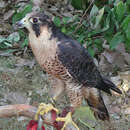en
names in breadcrumbs


Much larger (15-20 inches) than the Merlin, the Peregrine Falcon is most easily identified by its slate-gray back, brown-barred breast, and thick black “moustache” stripe. Other field marks include yellow eye-rings, a white throat, and yellow legs. Like most species of raptors, females are larger than males. The Peregrine Falcon inhabits every continent except Antarctica, and elsewhere are only absent from the interiors of tropical forests and large deserts. In North America, this species has a patchy breeding distribution from arctic Canada and Greenland south to central Mexico. In winter, this species is found along the Pacific coast of Alaska and Canada, extreme southeastern Canada, and south through much of the U.S., Mexico, Central America, the West Indies, and South America. In the Old World, this species is absent only from extremely dry, cold, and remote areas such as the Sahara desert, Central Asia, Iceland, and New Zealand. Peregrine Falcons breed in a number of habitats across North America. These habitats have in common prominent cliffs or ledges for nesting as well as open areas for hunting. Peregrine Falcons are known to breed on tundra, coast, and mountains, and have recently begun nesting on ledges of tall buildings in urban areas. Outside of the breeding season, this species also prefers open areas with prominent perches to aid in hunting. Peregrine Falcons primarily eat small to medium-sized birds, and will also hunt small mammals, including bats. Due to this species’ preference for open habitat, Peregrine Falcons may be most easily seen perched prominently, perhaps in a tall tree or on a cliff face, while watching for prey. This species may also be observed hunting, when it may be seen pursuing and capturing prey with its talons. This species is primarily active during the day.